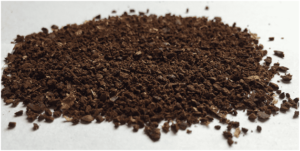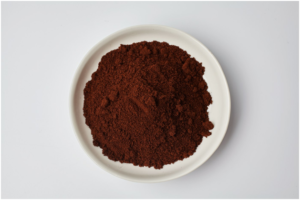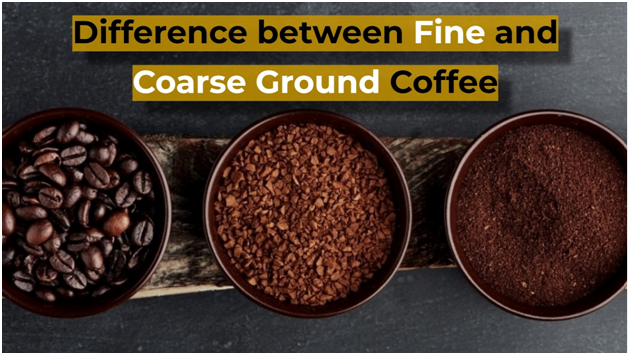The perfect cup of coffee requires a delicate balance. People always talk about the types of beans and brews and confuse themselves when it comes to selecting the grind size of coffee beans.
So if you, too, wonder: what is the difference between fine and coarse ground coffee—we’ve got you covered!
Today we’re going to find out if the size of the coffee grind makes a difference by comparing fine ground coffee to coarse ground coffee.
How good your coffee tastes depend on how big your coffee grounds are. Not only can the degree of grinding affect the flavour of your coffee, but the grinding process can spoil the whole brew pot. So, let’s take a quick look at the grinding process.
What is Coarse Ground Coffee?

The term “coarse grind” refers to the coffee ground with relatively big coffee bean particles, as its name implies. This means that the water might not pull out as much flavour, and the coffee might not be as bitter as it would be with finer grounds.
This grind is perfect for making coffee in a French press.
As was already said, there are different kinds of coarse coffee:
Coarse— it has the texture of kosher salt.
Medium–coarse— it has the texture of beach sand.
Extra–coarse— it has the texture of sea salt.
Pros
- The taste of coarse coffee is less bitter.
- It is easier to make because it needs less energy and machinery.
Cons
- It takes more roasting time to bring out the flavours in coarser grinds.
- Frequently produces under-extracted coffee.
Suggested read: where to buy coarse ground coffee for french press
What is a Fine Ground Coffee?

Coffee beans that have been ground finely enough to extract as much flavour over a little brew time are considered “fine coffee grind” – the usual coffee size we are familiar with. Finely ground coffee has a smooth, powdery texture.
When it’s mixed with hot water, its large surface area lets out a lot of flavours.
Pros
- To bring out the flavours, finer grinds need less time to roast.
- It may be used to prepare a variety of unique coffee beverages, such as Cappuccinos and Lattes.
- Richer flavours and stronger cups are the results.
Cons
- Has more brewing restrictions.
- Needs more energy (heat and pressure) to make the perfect cup.
What is the Difference Between Fine and Coarse Ground Coffee?
When it comes to coffee, you can choose from two main types of grinds – fine and coarse. Both have their own unique benefits and drawbacks, so it’s important to choose the right one for your needs.
So what is the difference between fine and coarse ground coffee? Let’s understand the answer!
Brewing Method
The first thing to consider when choosing a grind is the brewing method you’ll be using. For example, for drip coffee, use a medium-coarse grind. This will ensure that the water has enough time to extract all of the flavours from the coffee grounds but not so much time that the coffee becomes bitter.
On the other hand, if you’re using a French press, you’ll want to use a coarser grind. This is because the longer brewing time associated with this method can result in bitterness if you use a fine grind.
Taste
The grind you use will also have an impact on the taste of your coffee. Generally, a finer grind will result in a stronger flavour, while a coarser grind will be milder. This is because a finer grind exposes more of the surface area of the coffee bean, allowing more flavours to be extracted.
A coarser grind, on the other hand, will have less of an impact on the flavour of the coffee. This is because the larger grinds don’t allow for as much contact with the water, resulting in a less concentrated flavour.
Brewing Time
Another factor to consider is brewing time. Generally, fine grinds require less brewing time, while coarse grind requires more. This is because a finer grind allows the water to extract the flavours from the coffee more quickly.
A coarser grind, on the other hand, will take longer to brew. This is because the larger grinds don’t allow for as much contact with the water, so it takes longer to extract the flavours.
Grinding Time
The final thing to consider is grinding time. A finer grind will take longer to grind, while a coarser grind can be done more quickly. This is because it takes more time to break down the coffee beans into fine powder.
On the other hand, a coarser grind can be done more quickly because the beans don’t need to be ground down as much.
So the main difference is in the brewing method, taste, brewing time, and grinding time. Consider these factors when choosing the right grind for your needs.
Which is Better Anyway?
Selecting a grind size should maximize coffee flavour. You may get a sour, acidic, or salty flavour if you don’t extract it properly. Too much extraction will result in too much flavour. Without distinguishing flavours, it tastes bitter. So, it all depends on what you’re looking for. Finer grinds extract faster and have greater flavours.
The brewing process and water temperature are the most significant factors. Sometimes the coffee grind size is right, but the temperature and duration are inaccurate. The recommended expresso grind (fine) differs from cold brew or French Press (coarse.)
Conclusion
Grind size affects coffee flavour. Coffee may be under or over-extracted if ground is too coarse or fine. Because you brew coffee with water, you don’t want the beans ground in a manner that modifies flavour, acidity, and taste.
Coffee taste depends on how finely or coarsely it’s ground. Depending on your brewing technique, incorrect grind size can alter the coffee flavour. We believe now you have a better idea of which coffee grind size to use while making a perfect cup of coffee.



